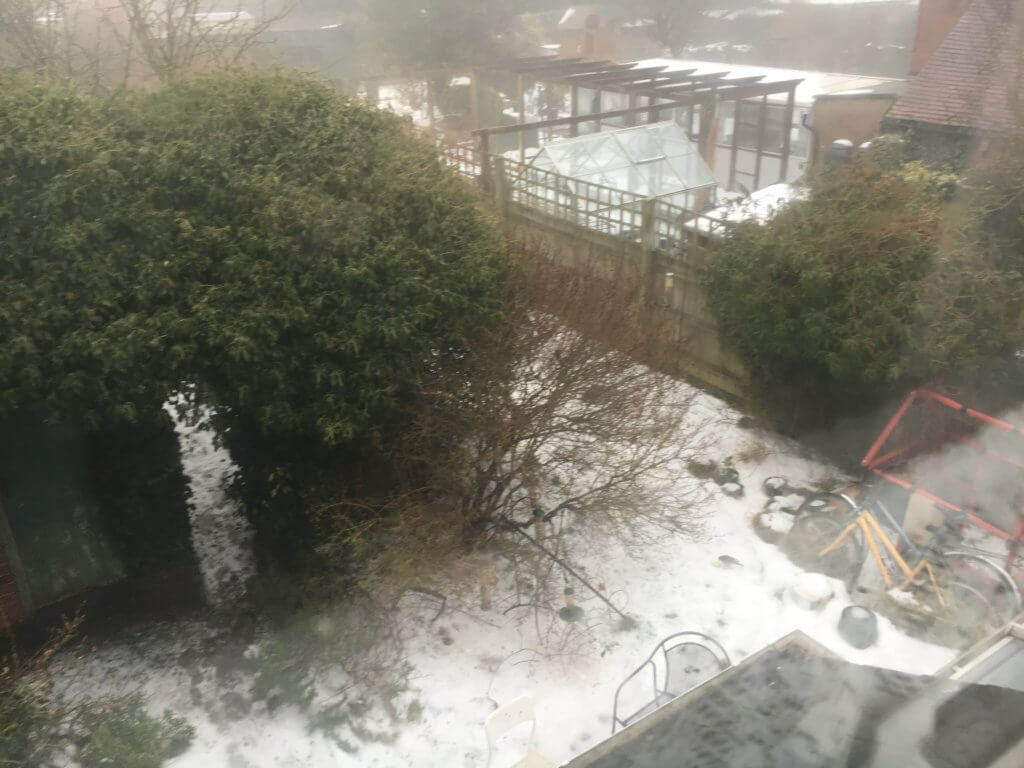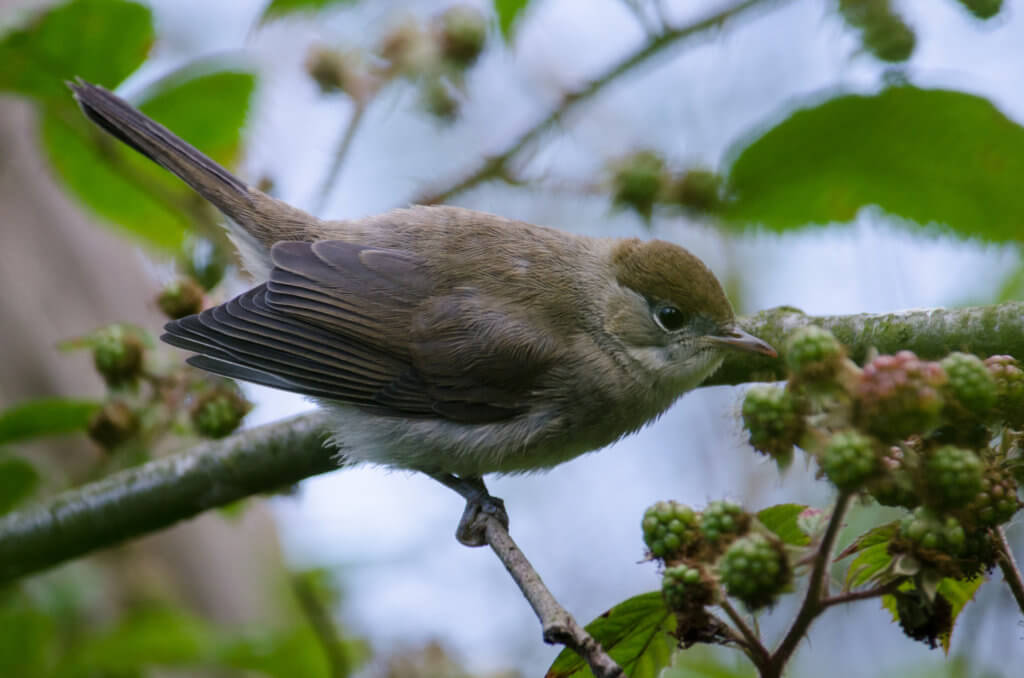
It’s still snowy here in east Northants – snowy and misty.
Yesterday I saw 23 species of bird from the house: Red Kite, Black-headed Gull, Common Gull, Woodpigeon, Collared Dove, Carrion Crow, Jackdaw, Blue Tit, Great Tit, Long-tailed Tit, Blackcap, Starling, Song Thrush, Blackbird, Fieldfare, Robin, Dunnock, House Sparrow, Pied Wagtail, Chaffinch, Greenfinch, Goldfinch, Reed Bunting. That’s most of those one could expect to see on a winter day (complete list over 13 years of Birdtrack records is 52 species including such treats as Cuckoo, Goshawk and Common Tern).
All but the kites, gulls and corvids were making some use of the bird food provided in the garden.
There were up to three Fieldfares in the garden at any one time – they are quite aggressive to each other and the other birds, but everyone got a look in eventually. And Fieldfares in the garden is a sign of a prolonged cold spell (with snow on the ground). They never come into the garden to feed on apples when the weather is mild. It’s obvious from social media that others are seeing these common farmland winter visitors in their gardens because of the snow cover too.
And the female Blackcap (let’s assume it is the same one each time (as seems likely)) that has been around for a few weeks, is still a regular visitor to the fat balls. Birdtrack confirms that my winter Blackcap garden records never start before mid-January and then usually last through January and February and sometimes into the first few days of March ie until around now. I’ll let you know whether this one stays longer.
But Birdtrack also shows me something that I would not have remembered without its help; in 2013 my first garden Blackcap was in late January, there were a scattered records through February and they continued into early March, but also 17, 23 and 24 March and also 6 and 7 April. We don’t get Blackcaps in or around the garden in spring or summer. It’s impossible to say without marked birds but it looks as though in that year ‘my’ Blackcap arrived in late January and stayed until early April. I wonder why?
And I expect today will be similar to yesterday as far as birds are concerned – but I can be perfectly sure that it won’t be exactly the same.

Similar story with Fieldfares in Sheffield. Don’t see them most winters but several now aggressively defending the apples we put out for the Blackbirds. We have a solitary male Blackcap – likes drinking from the regularly topped up water bowl.
I have a visiting male Blackcap here on the coast South of Aberdeen for the first time this year but he arrived in early December. The single Redwing I acquired last week is a regular visitor now. I had a single male Blackcap every year when I lived in Fife.
I have a poor selection of birds here, but I make up for that in quantity, usually 40 or 50 feeding at a time, mainly Goldfinch, Greenfinch and Chaffinch.
In bad winters (We have not had it bad here comparatively), we have had a Woodcock and a Sparrowhawk less than 20 feet from the passing buses for days at a time.
Presumably your winter Blackcap is a German bird – and if its right that this apparently new migration is prompted by the availability of food on British bird tables I suppose their return to Germany could be partly determined by that food supply dropping off here in spring.
I read somewhere recently (can’t remember where sorry) that the origin of UK wintering Blackcaps is a very complicated matter with some coming from, maybe, Germany for the winter, while others are UK breeders, that would normally winter in the W. Mediterranean, that decide to overwinter here. There was talk of two separate races I believe.
Can’t just remember seeing Goshawk through the window, (although the electrician, working in the kitchen, saw one take a young Rabbit off the lawn when I was at work once), but on quiet spring
evenings I used to hear them calling from 600yds away across the valley, and that was with the window closed !.
Trapit – well I was in the garden for that one – it flew over to reward me for remembering to bring in the washing.
What a difference a day makes to the birds in the garden, here near the Suffolk coast.
In the worst weather and the snow from Tuesday, the flow of small birds to the sunflower hearts seemed to be much reduced, we had the odd Siskin, Reed bunting and Brambling, amongst the usual Goldfinch, Greenfinch, Blue, Great and Long tailed tits. Before the snow though, the flow of small birds to, and waiting in the bushes for their turn for, the sunflowers and peanuts was almost continuous. In the mornings and evenings all the feed ports would be taken. The usual carpet of chaffinches that has under sown the feeders for ages vanished altogether.
After the snow the flow does not seem to have picked up this morning (Sunday)
The garden birds changed to a permanent attendance of a row of 15+ fluffed-up Fieldfares roosting next to their apples; well, for some of the time, when they were not fighting amongst themselves, or with a couple of Mistle Thrushes that turned up and the odd Blackbird. The Blackbirds wisely stayed away, under the feeder or on the cleared patch with spread fatty crumbs. Earlier in the winter there would be 17 plus blackbirds down the garden on the row of apples and no Fieldfares.
Now after the snow started to melt there is only the odd Blackbird on the apples and a few on the crumbs.
In the blizzards the Robins called a truce with five close up round the feeder and even three in the feed cage together.
One pied wagtail turned up and hunkered down fluffed up looking sad but spry enough to chase away two others that arrived and hung round the edges.
We only have a few neighbours and they already fed the birds so I don’t see them moving “next door”
As the fields froze before the storm the lapwings were flying everywhere and two found some soft ground under a cherry tree in the garden where they found some lovely big worms. When the snow came overnight I cleared it in a sunny spell, walked down the road to “Wild about Birds” and bought some live mealworms which kept them returning until the first signs of thawing.
The kestrel is back again on the roadkill pheasant carcass that has been frozen for days.
As I said what a difference a “day” makes to the birds in the garden.
PS As Sunday progressed the odd Fieldfare has popped in, two robins are still friends and there are Blackbirds but the feeders are picking up a bit.
I had the pleasure of 18 species feeding in my garden in Calderdale. (Approx 10 m x 15m) surrounded by trees and near a heather hillside.What has impressed me most has been the shear numbers of birds packed into quite a small area,easily 30 or more birds at any one time.The constant movement of them was hard to keep up with.
I have been keeping an eye on a Gt Tit that has lost all it’s feather on its head.I wondered whether it would succumb to the cold but it was still feeding yesterday.
The species were Great,Coal,Blue and Long tailed Tits,Song Thrush,Magpie,Wren,Dunnock,Wood Pigeon,Gt Spotted Woodpecker,Jackdaw,Jay,Blackbird,Robin,Nuthatch,Goldfinch,Bullfinch and Chaffinch.
I was looking out at our thick layer of snow and thinking, rather depressingly, how long it would take to melt away and let birds access food at ground level when I realized if wild boar were around their digging would expose food for some birds at least. I can’t think of another natural equivalent that could throw a bit of a lifeline to birds in these conditions. Another example of our rather reduced, dysfunctional ecosystem?
Les, excited dogs and kids, scuffing the snowy woodland floor, are fairly natural. Hungry Robins follow them closely while Wrens are not far behind. But agree, things would be better if crashing boars, wild bovines and early bears were around.
Yes was wondering if auroch would scuff up soil or revert to browsing, same with elk or would they stick with water weed? I hadn’t thought about bears!
Just having a contemplative, browsing Aurochs walking the walk will do the necessary disturbance. But a disturbed, non-browsing Aurochs would be even better for scuffs and stuff.
The elk’s role. It’s a moose point.
Someone on my facebook feed mentioned raking over his compost heap as a way of making some invertebrates available to the birds in his garden – not a bad idea in the absence off any wild boar to do the job!
Quite a few years ago, we had a wormery for waste. When our local female Blackbird came for her grub, I would often lift the lid off the wormery and she would dive in before they could disappear!
Have been noting first and last dates of Blackcaps in the garden in winter since 2002; earliest arrival 31/10/08, but regularly start of Nov; latest 4/5/12, but regularly to middle of April. Call me Granny Nerd!!
I have just started using Birdtrack and am encouraging others who are reluctant to publish on our local birding website to do the same.